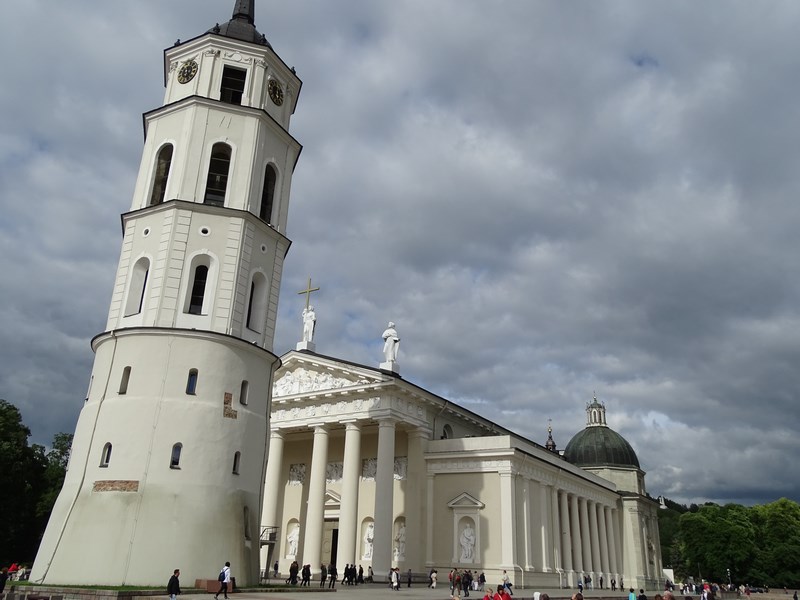The world’s last divided capital. Episode 1: Southern Nicosia
The geo-economic situation after WW2 led to the emergence of some strange, distorted, artificial “capital cities” divided between rival countries with militarized borders and frightening walls, passing by straight through the core of some dwellings that are hundred or maybe thousand years old: Berlin was divided between East and West, so was Jerusalem and starting with 1974, Nicosia was split in two: Lefkosia and Lefkosa! The heart of the town was severed by a barbwire border defended by UN troops.
Berlin unified by choice, Jerusalem by force, so that it remained only one divided capital – welcome to Nicosia, the capital of the ”two countries” called Cyprus.
I visited Cyprus almost four years ago. I wasn’t very much interested in its seaside resorts, but rather in some places that might divulge me the tragic story of this island as well as its present… Cyprus is not a very large island… when the plane prepares to land on Larnaca International Airport, one doesn’t need to have a quick and sharp vision in order to grasp the view of the entire island. But even so, here are no less than two countries placed in a virtual war – The Republic of Cyprus and The Turkish Republic of Northern Cyprus (the last being acknowledged only by Turkey).
In the next few days I’ll get into the story of the “two” Nicosia and submerge into the peculiarities and differences between the two cities, but leaving the story of the split for the last part of the journey when my steps will follow the Green Line and the frontier area… But for now, I decided to start with Southern Nicosia which is the Greek area.
After the separation, Cyprus (Southern part) came to know a spectacular development. The mercantile sense of the Greeks, an enlightening politics system that transformed the Republic into a commercial and financial center and most importantly, the sheltering of thousands of rich Christian Lebanese refugees from a country consumed by war and disaster, placed Southern Cyprus among the wealthy countries of the world, despite an obvious lack of resources. Tourism started to be promoted and luxurious seaside resorts emerged on the South-Eastern and Southern shores of the island, attracting millions of sunbathing enthusiasts.
The historical Nicosia is like a gist in the center of Large Nicosia… breathing stories from centuries ago, surrounded by Venetian walls… Before the Muslim occupancy, Cyprus was invaded by Venetians who transformed towns like Famagusta or Nicosia into impressive fortresses. The walls that witnessed so many transformations are still standing but without having stifled the city. The new city burst outside the center with apartment buildings, residential areas and wide highways. The old city remained somewhat suspended in time… some parts have been reconstructed, shed off their Oriental garments and have now a more European look. Perhaps the most eloquent proof is Ledra Street, the main commercial street with European style buildings, designer shops, McDonald’s restaurants and fancy terraces… But it is very difficult to break free from “the other side”… Ledra continues in Northern Cyprus where it transforms into a Turkish bazaar although it is the very same street!
Despite the fact that borders have been opened to the public and now it is very easy to reach “the other side”, I have the distinctive feeling that most of Southern Nicosia inhabitants have never set foot in the Northern parts of the city that can be seen daily from distance… Hatred takes over curiosity… But ignorance generates monsters – most Greeks have described to me the Northern part as some sort of Afghanistan! Even the Romanian lady from the traditional Romanian store on the Southern side was shocked to hear I intended to go in the North saying something like “Don’t go there! It’s dirty, poor, filthy and filled with nothing but thieves and crooks!” …”Have you ever been in the North?” I asked and the answer came straight and quickly: “No!”…All this coming from a Romanian born person, thus lacking the genetic inheritance of the Greek hatred towards the Turkish people. Pointless to say that in reality, the situation is not even by far this catastrophic.
Old Nicosia is not a very large town, but it has a remarkable diversity. Ledra is a classic European enclave with buildings that can be found anywhere in Europe. The Venetian palace of the archbishop takes me back to the imagery of Dalmatian towns while the abundant number of mosques reminds me that the Orient is a few steps away, although Cyprus had been an Eastern Christianity pillar. If you want to have a glimpse of the whole landscape, just go to Ledra Observatory which is situated on top of a tall building, if I’m not mistaking, the highest in the old town and from where you’ll have a wonderful view laying before your very eyes. And again, although you might like to ignore or deny the existence of the other side, it is absolutely impossible: your eyes cannot miss the grandeur of the immense Catholic cathedral that became a mosque or the giant flags of Turkey and Northern Cyprus sprayed on the Northern hills and which can be seen from many areas in the South… it is really impossible to ignore the other side.
Even when you get back to the ground, the image of the other side will follow you when walking on the Southern sidewalks as there are many mosques in the South… I enter one in the Orthodox area and find out that the Muslims here are “more Catholic than the Pope” – my girl friend must wear the Muslim hijab just like in The Mosque of Damascus. But in the Northern Cyprus won’t be necessary! On its walls, genealogical trees more or less done by hand, give away that in fact Muslims recognize Jesus, Solomon or Moses, all of them are the prophets and messengers of Allah, all of them are in the Koran and part of the Muslim religion… Then why are we all still fighting?
I reach the palace of the archbishop. The Archbishop of Cyprus has always been the leader of the Orthodox Church. During the times when Cyprus was under Venetian ruling, the Orthodox population was persecuted and many of them tortured in order to embrace the Catholic religion. When the Turkish invasion occurred, all the Catholics were chased away or killed, but the Orthodox were tolerated. Moreover, Ottoman administration wanted nothing to do with them. They needed a façade, a sort of interface represented by the archbishop who was acknowledged as leader of the Christian community, their representative and also in charge of putting into practice the taxes and laws of the rulers.
Due to this both laic and religious role played by archbishops, it is no wonder that the first president of Independent Cyprus was archbishop Makarios. Despite the fact that today, Cyprus has a civilian presidency, the archbishop continues to be for many the most important figure in the Republic, an aspect more than obvious when admiring his residence.
Near the palace of the archbishop are a few museums: one is dedicated to the fight for freedom, one is devoted to ethnography and the third is in the name of art. I admired a temporary exhibition entitled “Hostages in Germany” – a collection of religious artworks from Northern Cyprus that found their way into Germany where the Turks sold them… a photography exhibition with various religious artifacts taken from the remaining churches in North and sold in Germany. In Nicosia, by every step you take you are reminded that there’s another side… And “that other side” is mysterious, threatening, like a shadow of darkness dominating one’s existence and inducing paralysis.
I finally escaped the shadow of North in the Southern part of old Nicosia, near Constanza Bastion. Here is an area where you can find bars, al fresco restaurants, sizzling kebab and endless beer. It is here that you‘ll see all the smiles and the Greek way of life – unruffled, relaxed and always ready to embrace the fun side of life. It is the bright side of a haunted town… by North, by its past and its present. In the evening, near Constanza you can bump into Greeks and foreign tourists, while on Ledra you’ll cross path with immigrants – Indians, Sinhalese and quite an unexpected number of Romanians.
Southern Nicosia reminded me of the title of that famous Romanian TV series “Lights and shadows” – despite the presence of sun, there are areas clouded by hatred and pain, but also areas where smiling faces are everywhere. I think only time can heal those wounds, but if that intention really exists…
Tomorrow we are going in Northern Nicosia which is the place where only a few people from Southern Nicosia have ever been to.
Photos of Nicosia:
Ledra street – it starts in the Greek South, it ends in the Turkish North
Ledra Observatory – for a peek in the Turkish Nicosia
The North Cyprus flag can be seen from the whole island !
Selimye Mosque (formerly, a Gothic Cathedral) is now in the Turkish part
Modern Nicosia seen from the Ledra Observatory
The Green Line which splits the city
A map of Nicosia. Of the whole Nicosia !
Faneromani Church
A mosque in the South, Greek part
South Nicosia streets
Altough Greek dominated, there are stil lots of Muslim monuments
Ladies need to be properly dressed in Omerye mosque !
Muslims recognise Jesus as messenger of God
Archibishop’s palace
The exhibition showing Orthodox artifacts sold from North Cyprus to Germany
The streets can be really picturesque
The area full with small, nice restaurants













As someone who travels through im not sure if you could completely sum up and understand the reasons of “hatred”. besides it is poor dirty most of the people are offensive and now we are not only talking about Nicosia`s turkish parts. The article is not accurate it degrades the people. I wouldnt call it ignorance. And asking a romanian woman is not the most trustable resource to ask… What does she know about the history and the reasons?The facts are not accurate the mosque should not be so highlighted in the southern nicosian aspect… I suggest if you want to discuss about such things you need to see the history better. I did not like this article because it said nothing about nicosia. Nicosia is not only a Ledras street and the walled city. You have to see all the occupied cities together and talk to locals and according to all the gathered information should write and informational article… Peace.
“Nicosia is the world’s last DIVIDED CAPITAL” is NOT true info!
THE CITY is divided, NOT the CAPITAL:
The capital of Northern Cyprus is NORTH NICOSIA and it FULLY belongs to Northern Cyprus.
The capital of Cyprus is SOUTH NICOSIA and it FULLY belongs to Cyprus.
The sovereignty CLAIM of Cyprus over NORTH NICOSIA does not make NICOSIA a DIVIDED CAPITAL.
The language, religion, culture, and race of NORTH Nicosia are TURK.
The language, religion, culture, and race of SOUTH Nicosia are GREEK.
TWO COMPLETELY DIFFERENT THINGS POSITIONED AS SIDE BY SIDE CANNOT BE CALLED AS “DIVIDED”!
North is Turkish and the TURKISHNESS in north is NOT DIVIDED!
South is Greek and the GREEKNESS in south is NOT DIVIDED!